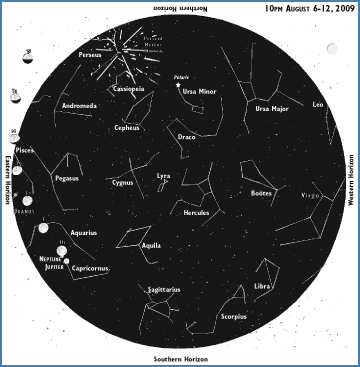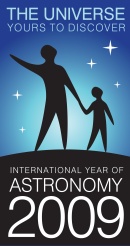
Volume XVII, Issue 32 # August 6 - August 12, 2009 |
 |
 |
Sky Watch
by J. Alex Knoll
At the Edges of Darkness
From planets at dusk and dawn to meteors piercing the night
Shortly after sunset Thursday, around 8:10, the just-waning gibbous moon rises with brilliant Jupiter a few degrees to the south. The two remain a couple through the darkness, and as the sun crests the northeast horizon Friday morning, about 6:10, they sink toward the southwest horizon. Armed with a telescope, you may be able to discern Neptune between the moon and Jupiter; with more than 21⁄2 billion miles between us, the distant planet appears as a small speck of light with a blue-green hue.
 Sunset finds Saturn poised low against the western horizon at the edge of darkness, visible for an hour or so at best in these last week’s of its night-sky apparition. Even so, the planet is not its usual self, as its rings face the sun edge-on this week. As such, the reflective area of the planet is greatly reduced and appears to the unaided eye subdued compared to its more brilliant self. In a telescope, the change is even more stark, as the rings have practically vanished, appearing at best as a dark hairline shadow against the planet’s surface.
Sunset finds Saturn poised low against the western horizon at the edge of darkness, visible for an hour or so at best in these last week’s of its night-sky apparition. Even so, the planet is not its usual self, as its rings face the sun edge-on this week. As such, the reflective area of the planet is greatly reduced and appears to the unaided eye subdued compared to its more brilliant self. In a telescope, the change is even more stark, as the rings have practically vanished, appearing at best as a dark hairline shadow against the planet’s surface.
At the other edge of darkness, Venus blazes in the east, hailing the coming dawn. More than 10 degrees higher but about 1⁄10 as bright is Mars, appearing as a grungy-red blob.
This year’s annual Perseid meteor shower, which peaks overnight Tuesday-Wednesday, competes with the waning moon, limiting the quantity of shooting stars. But because of the dense trail of debris strewn from comet Swift-Tuttle, quality should make up for any drop in numbers with plenty of big ones burning bright enough to dazzle and burn through the darkness. Plus, there will likely be strays over the following week as the moon continues to wane.
Illustration: © Copyright 1925 M.C. Escher/Cordon Art-Baarn-Holland; Graphics: © Copyright 2009 Pacific Publishers. Reprinted by permission from the Tidelog graphic almanac. Bound copies of the annual Tidelog for Chesapeake Bay are $14.95 ppd. from Pacific Publishers, Box 480, Bolinas, CA 94924. Phone 415-868-2909. Weather affects tides. This information is believed to be reliable but no guarantee of accuracy is made by Bay Weekly or Pacific Publishers. The actual layout of Tidelog differs from that used in Bay Weekly. Tidelog graphics are repositioned to reflect Bay Weekly’s distribution cycle.Tides are based on National Oceanic and Atmospheric Administration and are positioned to coincide with high and low tides of Tidelog.
